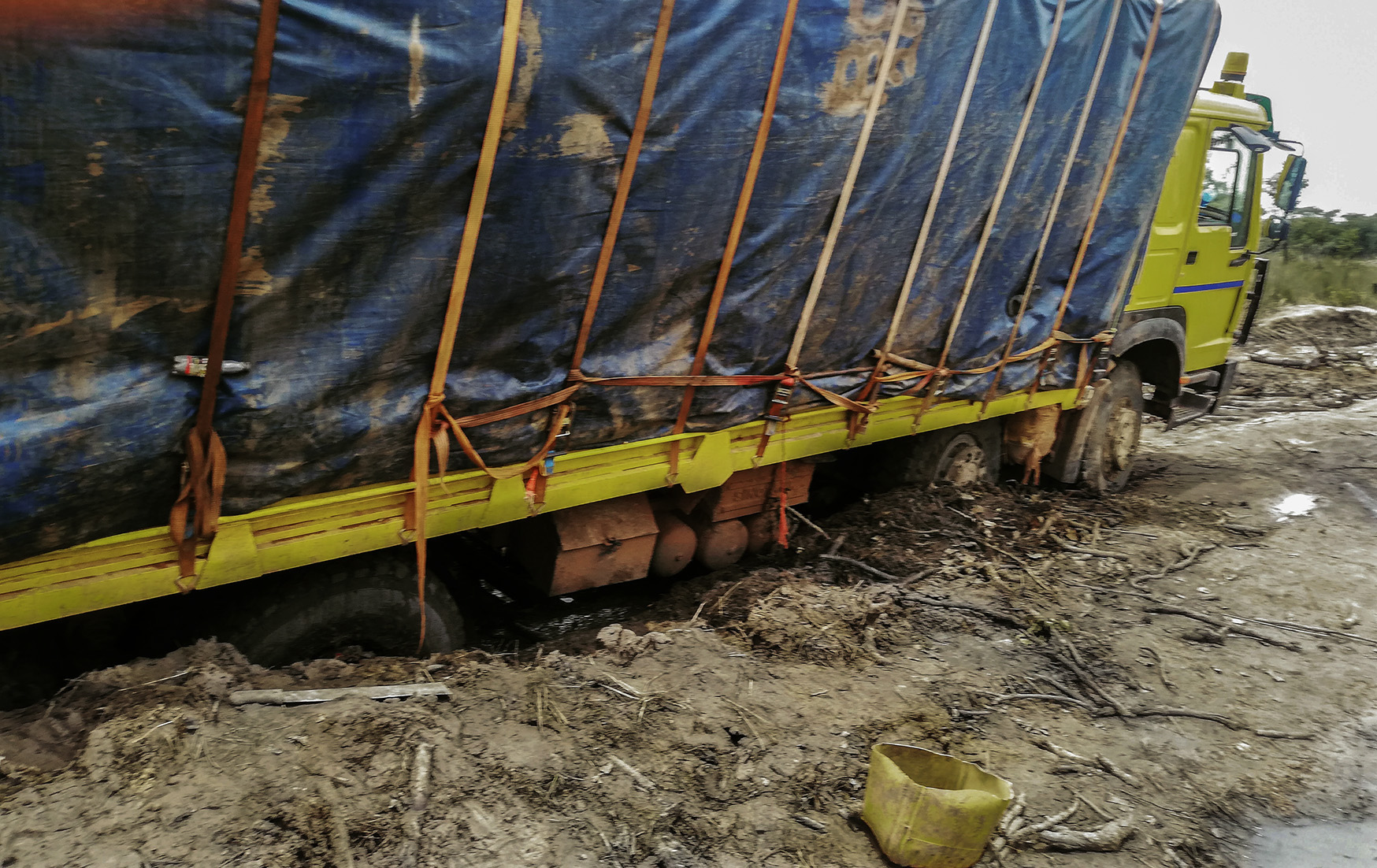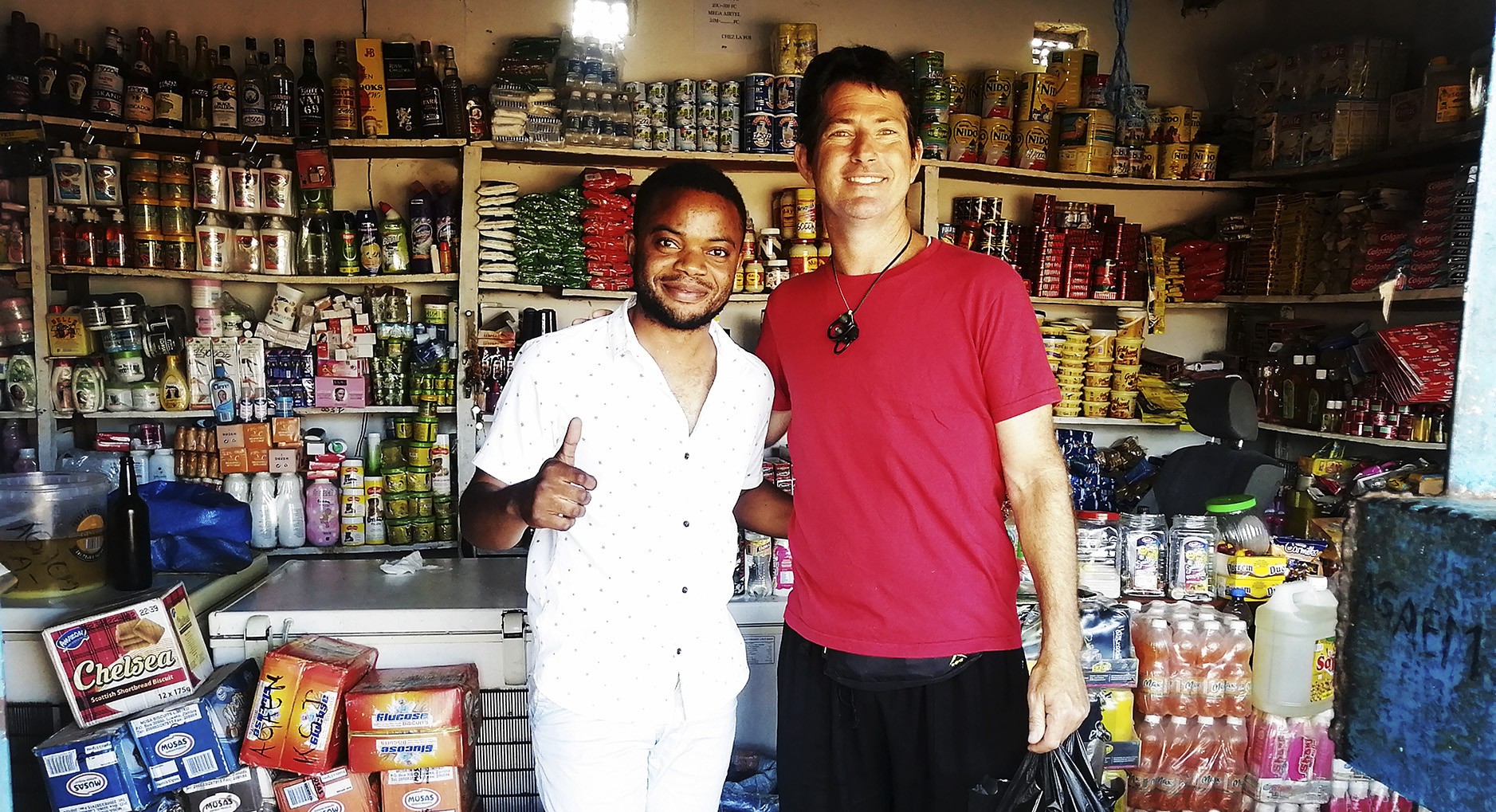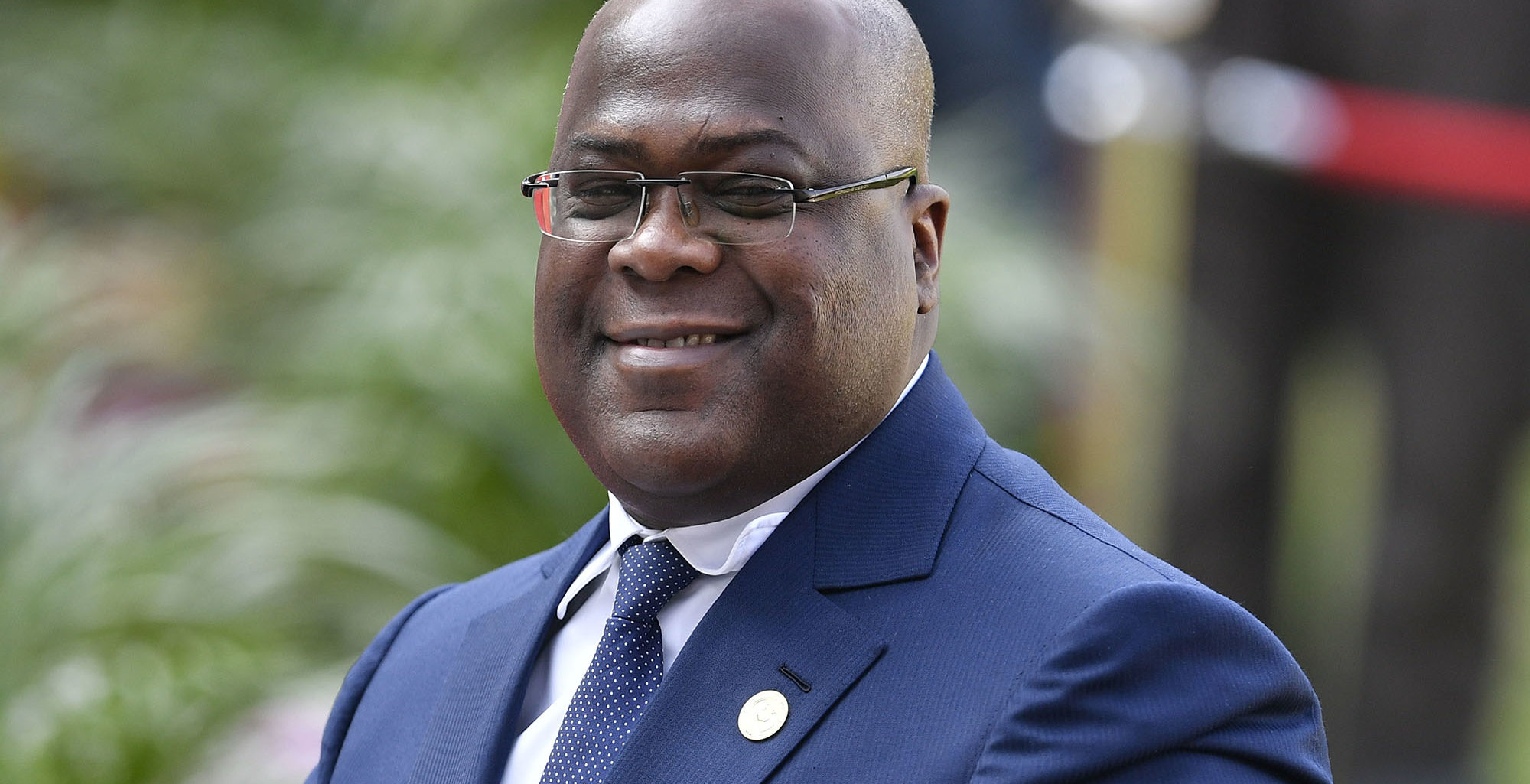Time for South Africa to take a fresh look at the DRC
- Get link
- X
- Other Apps
By Dave Martin• 1 June 2021

A truck stuck in one of the endless mud holes on the RN39 in the Democratic Republic of Congo. The truck is painstakingly lifted centimetre by centimetre, tree stump upon tree stump, over the next couple of days until it is free — only to get stuck again further along the road and for the exercise to be repeated. (Photo: Dave Martin / Rejane Woodroffe) Less
We need to build a road. A road into the Congo. The goal should be that within five years, one could drive from Durban to Kinshasa on a decent road. That would transform the lives of tens of millions of Congolese and open a massive market to South African products.
Fabrice Tshombe* straps 10 plastic jerrycans to his single-speed bicycle and begins cycling out of his home town of Musumba in the south of the Democratic Republic of the Congo (DRC). It will take him four days to cycle 400km down the RN39 road to his destination of Dilolo, a town on the border of Angola.
When Fabrice arrives in Dilolo, he fills each of his 10 jerrycans with 20 litres of petrol and then straps this 200kg load tightly to his bicycle. To provide extra strength to his bicycle’s frame, he has strapped hardwood tree branches to the main load-bearing supports as well as a single vertical branch that sticks up at head height which helps him keep his bicycle upright.


Fully loaded, it is impossible to cycle and Fabrice has to push his bicycle back to Musumba. The next 10 days will be spent heaving his bicycle through 400km of soft beach-like sand and slipping around and through endless mud holes. Each time the bike topples over, he will have to wait for someone to come by and help him lift his bike upright again.
En route, Fabrice sleeps in small forest villages where he can buy a plate of fufu (a pap made from kasava and maize) and pondu (pounded kasava leaves) for a dollar. Every few days on this exhausting journey, he passes an old truck deeply stuck in one of the endless mud holes. The truck driver and his gang of helpers stand knee-deep in the putrid-stinking mud as they use a jack to lift the truck a few centimetres at a time and then slide a tree stump harvested from the forest under one of the wheels.


(Photo: Dave Martin / Rejane Woodroffe)
Painstakingly the truck is lifted centimetre by centimetre, tree stump upon a tree stump, over the next couple of days until the truck is free of the quagmire. The truck then drives for an hour or two, slipping, sliding and bulldozing its way through the mud until it is captured by the next quagmire where once again days will be spent knee-deep in the mud, jacking up, sliding in a tree stump, jacking up, sliding in a tree stump.
Fortunately for Tshombe, there is always a narrow route for his bicycle to bypass the worst mud holes and so, even though he’s travelling by foot, he will reach Musumba before the truck does. Two weeks after leaving Musumba, he has returned with his full load of 200 litres of petrol that he can sell for a profit of $50 (R700). After a few days’ rest, Tshombe sets off again with his empty jerrycans to fetch another load of petrol. As he leaves town, he passes the truck as it finally arrives in Musumba, three weeks after it departed Dilolo.


The truck driver parks outside one of the small shops that line Musumba’s main road and the offloading begins: powdered milk, tinned fish, margarine, biscuits, alcohol, soap, shampoo, toothpaste and soft drinks are packed on the shop’s shelves. The truck won’t transport petrol as it is too heavy and doesn’t generate enough income to cover the costs of the long, arduous journey. Each truckload is a complex calculation of weight and volume versus value with the preference being for small, light and valuable goods. After a few days’ rest, the driver jumps into his truck and heads back down the same road to inevitably get stuck in the same mud holes where he will again stand, knee-deep in mud — jacking up, sliding in a tree stump, jacking up, sliding in a tree stump.
In Musumba and other rural towns and cities in much of the DRC, the dire state of the roads has resulted in every litre of fuel being transported by bicycle. The state of the roads also means that public transport is limited to either walking or travelling on the back of accident-prone motorbike taxis that can cover about 150km in a day at a cost of about $30 per person. In a country where the GDP per capita is about $50 per month, this fee is out of reach for most rural Congolese so movement is difficult. Most people have never seen the neighbouring province, many have never even seen the neighbouring town. The cost of transporting goods on these terrible roads has resulted in some of Africa’s poorest people paying the highest prices for consumer goods.
How a country with such incredible mineral wealth came to experience such a tragic level of infrastructural collapse over the past 60 years is a well-known story of corruption and war and yet, in all this hardship, one can see seeds of hope, not only for the DRC, but possibly, South Africa too.
Since the dawn of democracy in South Africa politicians and economists have been calling for rapid economic growth to address poverty and rising unemployment. Yet it has been difficult for anyone to convincingly describe what the engines of this rapid growth might be. The country has been trapped within a low-growth trajectory for decades where our perennial 5% GDP growth target appears to be just wishful thinking. Despite countless ambitious economic plans, nothing substantial seems to change. We need a new vision and perhaps we can learn something from the country that ended poverty in a generation: China.
China’s Belt and Road Initiative is an ambitious plan to build excellent infrastructure in a network of countries and claims to be a win-win exercise whereby poorer countries gain excellent infrastructure while China benefits from easier access for its exports into new markets. Obviously, China is going to choose to support only those infrastructure projects that are mutually beneficial. There is little chance it will build infrastructure that helps the US, or any other country for that matter, gain access at China’s expense. If anyone else wants better access, they would have to initiate their own infrastructure projects.
Of course, South Africa can only dream of having the financial resources that China enjoys but, for a relatively small investment, South Africa could create its own mini-belt-and-road project that draws the DRC closer into SADC and South Africa’s sphere of economic activity.
One might question the upside of integrating South Africa’s economy with that of a failed state prone to war and disorder, but that misses the fact that there are emerging, hopeful signs that the DRC might be turning the corner.


In 2018, the DRC experienced the first democratic transition of power in its history — a feat that South Africa is yet to accomplish. Initially, the new President, Felix Tshisekedi, son of longtime opposition figure Ettiene Tshisekedi, was thought to be at least partly under the control of former President Joseph Kabila.
However, to the surprise of many, President Tshisekedi has over the past year systematically sidelined the controversial former president and removed Kabila’s allies from various key government positions. At the same time, Tshisekedi has formed a loose alliance with Moise Katumbi, the former governor of the mineral-rich southern province of Katanga. Katumbi’s story is itself unusual: a hugely popular billionaire born to a Congolese mother and a Greek Jewish Holocast refugee.
Katumbi achieved impressive results during his eight years as Katanga’s governor: annual revenues from mining climbed from $100-million in 2007 to $1.2-billion six years later, partly thanks to an increase in production of copper cathodes from 18,000 tons to more than one million tons during that time. Access to water climbed from just 5% of the population to 67% and school enrollment increased from 400,000 (15% girls) to 1.2 million (45% girls).
It is clear that Katumbi has national political ambitions. While he is now in a loose alliance with the president, it is likely that Katumbi will stand against Tshisekedi in the next presidential elections. Given that neither Tshisekedi nor Katumbi has a history of leading armed militias, one can be cautiously optimistic that whoever wins the next election, the loser will not start a war. So, barring any nasty surprises — sadly the country has experienced too many of these — the DRC can be hopeful of a decade of relative political stability at the national level.
The notoriously conflict-ridden eastern border regions of the country will probably remain a cauldron of horrific violence, but they are not representative of the security situation in the rest of this enormous country which covers an area the size of Western Europe. South Africans can also be proud that our armed forces continue to play a crucial peace-keeping role in eastern DRC, famously playing a decisive role within the UN force that defeated the notorious M23 rebel group in 2013.
This cautious optimism about the DRC is shared by some in the mining industry. The Canadian company Ivanhoe Mines has completed the construction of what could soon be the world’s largest and most profitable copper mine in the southern city of Kolwezi. This mine represents an investment of billions of dollars and is a very large bet on the future stability of the DRC. Kolwezi, not coincidentally, is at the end of the good road that leads south into Zambia and on to the port of Durban. The same road carries almost all the minerals mined in Kolwezi, neighbouring mining city Lubumbashi as well as in Zambia’s mineral-rich Copperbelt to Durban and then on to the outside world. Expensive mining equipment makes the same journey in reverse.
Beyond Kolwezi, the mineral riches continue, but are largely exploited by artisanal miners or small-time, international adventurers with very short-term goals and little money to invest. While there are innovative attempts under way to formalise the artisanal miners — particularly the chaotic cobalt sector — there is an important role to be played by respected mining giants who can be held to international mining safety standards and who can be regulated into paying living wages and desperately needed taxes to the DRC government.
The mineral riches of the DRC are legion, but what economic analysts often miss is that there are 105 million Congolese who are using US dollars every day to buy consumer goods like milk powder, shampoo and tinned meat made expensive by the terrible truck journeys required to deliver these products to tens of thousands of small shops scattered across the country.
The population of the DRC alone is almost the size of the rest of southern Africa combined. The source of these consumer products are not determined by price, but by road infrastructure. In the far south of the country, the products are made in either South Africa or Zambia. In the west of the country, they come from Brazil and Europe via Angola. In the north, the products are mostly from Europe via the DRC’s only sea port of Matadi. In the east, the products come overland from Kenya and Tanzania. Even if the toothpaste from South Africa is cheaper than that produced in Brazil, the shops will stock Brazilian toothpaste if the only passable road heads west to Angola.
To indicate the size of this market, Zambia and the DRC combined buy roughly as much from South Africa as the United Kingdom does. And that is with South Africa having just scratched the surface of the DRC consumer market.
So what would it take for South Africa to better integrate the DRC into its economy through a mini belt-and-road-type initiative? How does South Africa, lacking China’s immense wealth, help the DRC to repair its roads and connect them into South Africa’s logistics network?
There are a couple of options.
One would be to build a network of basic rural toll roads that could be funded by an agency like the Infrastructure Fund or the African Development Bank. These roads don’t need to be expensive, time-consuming, asphalt roads. A network of good gravel roads that would allow vehicles to travel at 50km/h in all weather conditions would be transformative and would save Congolese transporters many multiples of any toll fee through fuel savings, less wear and tear and, most importantly, time.
Another option could be a smaller version of the “infrastructure for minerals” deals that China has done elsewhere. A mining company could be given mining rights in, for example, the town of Mutshatsha, provided they first build a good road to Kolwezi.
Whatever the Congolese state loses in terms of mining rights revenues from this exchange would be more than compensated for by the arrival of other mining investors willing to buy mining rights once there is a decent road. These “infrastructure for mining rights” deals could be repeated by making similar deals in strategically located towns throughout the region to ensure that the end result is a network of driveable, all-weather roads bringing the DRC’s population together and simultaneously creating an easy route for goods to move in either direction. (The DRC produces excellent coffee that sells in rural markets for less than R30 a kilogram. Avocados sell for less than R1. SA’s trucks would not need to return empty. )
Whichever approach works, the goal should be that within five years, one could drive from Durban to Kinshasa on a decent road. That would transform the lives of tens of millions of Congolese and open a massive market to South African products.
And what of the bicycle transporters like Fabrice Tshombe who would inevitably lose their businesses? They should be first in line for the thousands of construction jobs that this programme would generate: harder-working men would be difficult to find anywhere.
President Ramaphosa, please take the initiative. How about a bilateral with President Tshisekedi to launch this win-win idea? That would provide private-sector investors with the comfort that they won’t have to deal with an endless line of corrupt, lower-level officials trying to muscle in and get a cut of the action. What better way to practically demonstrate the benefits of the new African Continental Free Trade Agreement?
If South Africa is to get out of the mudhole of economic stagnation, we can’t just be endlessly clawing our way out of one hole only to fall into the next. We need to do something big and fast. We need to build a road. A road into the Congo. DM/MC
* Fictitious name
Comments
Post a Comment